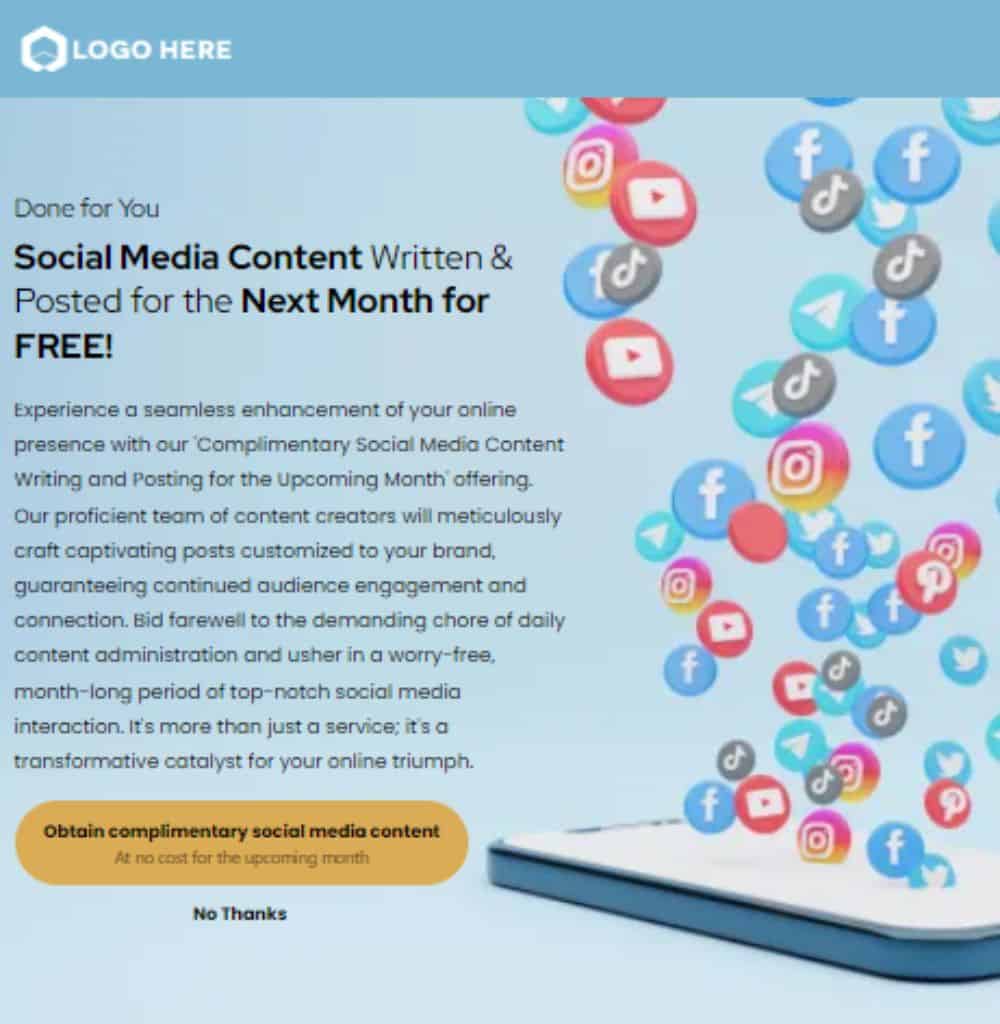There are various methods to achieve an affiliate conversion.
Using a simple funnel can lead to higher conversions compared to immediately directing cold traffic to a merchant or advertiser, especially when promoting expensive or complex products.
To achieve optimal efficiency and increase sales, it is important to prioritize delivering high value, building trust, and making accurate product recommendations. Additionally, the power of urgency and scarcity should not be underestimated, as they can generate excitement and encourage purchases.
Would you like to enhance your affiliate marketing results with a low-maintenance funnel that consistently improves over time?
Now, let get started!

What’s an Affiliate Marketing Funnel?
What’s an Affiliate Marketing Funnel?
Affiliate marketing enables brands to expand their reach by utilizing affiliates who promote their products across various platforms such as websites and social media. The affiliate marketing funnel is a helpful tool that assists marketers in understanding the user journey from initial website discovery to final purchase.
Creating an efficient affiliate marketing funnel assists marketers in converting leads into loyal customers and increasing product sales. This strategy enables you to engage users, regardless of their intent to purchase or simply browse. The sales funnel typically consists of four steps, reflecting the customer journey from website discovery to purchase.
- Introducing our brand, we aim to raise awareness.
- This may help increase audience engagement and interest in your work.
- This is a presentation on the benefits of our brand and the products we promote.
- Please take into consideration the option of making a purchase.
Affiliate marketing funnels ultimately enhance strategy effectiveness and improve return on investment.

A typical affiliate marketing funnel includes the following elements that are known for their efficiency:
- Content is a great way to share solutions and help solve problems for your audience. It provides a perfect context to introduce and promote products with affiliate links. By using keywords and SEO optimization, your content can also drive search traffic for a long time.
- An opt-in page can be used to retain readers who have not yet made a purchase by encouraging them to sign up for a newsletter. This allows for the introduction of more relevant affiliate products, notifying users of upcoming campaigns and deals, and expanding the customer base.
- The presell landing page connects your blog or social media content to the product page. It convinces users to make a purchase by highlighting the benefits and features of the product. It may also include customer reviews and star ratings. A strong call to action is crucial for every presell landing page.
Why Do You Need a Sales Funnel in Affiliate Marketing?
Developing a sales funnel can be beneficial for affiliate marketers in reaching their objectives.
- To increase your subscriber base, it is important to have a sales funnel in place. Without one, you may struggle to generate clicks on your affiliate links. A well-designed sales funnel guides users towards making a purchase.
- By monitoring your performance and tracking clicks on every page and stage of the funnel, you can gain insights into what resonates most with your audience and identify areas for improvement.
- The provision of customer value is crucial at every step. Regardless of whether your reader is looking to make a purchase or simply seeking information, both are equally significant in the context of an effective sales funnel. Even if a user is not currently in the buying mindset, the value you provide may persuade them to make a purchase at a later time.
- Developing an affiliate marketing funnel requires the preparation and implementation of comprehensive marketing and content strategies, which can lead to expertise in the niche.

What a sales funnel for affiliate marketing looks like
According to the principles of the buyer’s journey, an affiliate marketing sales funnel typically follows this structure:
The initial step involves directing traffic to your offer through strategically written blog posts, paid advertisements promoting a free offer, and utilizing various social media platforms such as Pinterest.
In the second stage, the focus is on converting the traffic by offering something for free. The objective is to get them to join your email list, where you can have more control over their journey and have repeated selling opportunities.
The third stage prepares your audience and improves conversion rates before presenting your offer in the fourth and final stage.
5 Benefits of a Sales Funnel for Affiliate Marketing
Unlock the hidden potential of an affiliate marketing funnel and prepare to be amazed by the stunning results! Say goodbye to boring links and dull advertising – get ready to dive into the enchanting world of a carefully crafted funnel!
Discover the game-changing benefits of building your very own affiliate marketing funnel!
1. Reach more prospects
Depending solely on advertisements may lead to a significant decrease in potential buyers, as studies have shown that up to 72% of individuals begin their purchasing process with a search.
However, it is not simply about writing blog posts and including affiliate links in them.
At this stage, buyers are looking for educational material, so producing free content in that area increases the chance of attracting more people to make future purchases through your affiliate links.
2. Boost your conversion rates
Lead nurturing leads to improved conversion rates, which is not surprising.
To effectively nurture leads, it is essential to have a thorough understanding of them. This understanding enables the delivery of more targeted and personalized assistance, which in turn can enhance brand trust and increase conversions.
With an affiliate marketing funnel, you have the opportunity to monitor every stage of your funnel, allowing you to identify and resolve any issues in your process. Are individuals showing interest in your emails but not following through to the offer page? Alternatively, perhaps they appear enthusiastic about the offer until they reach the offer page, at which point there is a lack of response.
Using a step-by-step funnel provides clear insights into drop-off points and enables easy identification of necessary improvements.

3. Bag repeat sales
One advantage of creating an affiliate marketing funnel instead of just adding links to a blog post or driving ad traffic directly to a sales page is the chance to create your own list of buyers.
This implies that instead of exerting effort to make a singular sale while the merchant you’re referring leads to benefits from your efforts by expanding their list, you’ll possess your own list that allows you to sell more products in the future.
4. Increase brand trust and authority
An affiliate funnel is designed to provide customers with value throughout every stage of the buyer’s journey. This ensures that even if they decide not to make a purchase, there is no negative association because you are not simply interrupting them on a Facebook or Instagram feed, but rather delivering value.
This results in increased conversions and builds trust in the brand.
Additionally, due to the education that leads receive, they have a clear understanding of their preferences and only make purchases when they are genuinely prepared. This is crucial for minimizing buyer’s remorse, enhancing customer satisfaction, and reducing refund requests.
5. Command higher affiliate commissions
Product owners are aware of the different levels of traffic quality and are willing to allocate more resources for leads of higher quality.
When the traffic you send to merchants has a higher conversion rate and fewer refund requests, you have the opportunity to negotiate higher affiliate commissions, regardless of the amount of traffic you are currently sending.
How To Build An Affiliate Marketing Funnel in 5 Steps
Are you prepared to develop an affiliate marketing funnel that effectively converts potential customers and enables the opportunity for negotiating higher commissions?
Here is a five-step system to assist you in achieving that.
We will be working in reverse order through these steps to establish a strong foundation for an efficient funnel.

Step 1. Choose your offer
A successful affiliate marketing funnel depends on having a strong offer at its core. If you haven’t created one yet, here are some helpful tips to guide you:
- Select a product that you are familiar with. Extra credit if you already use and have a positive opinion of it.
- It is essential for your audience to see the relevance of your product pitch. If prospects cannot understand why the product is being presented to them, they are unlikely to make a purchase.
- Consider checking online reviews on reputable websites such as G2 and Capterra, as well as the product’s social media handles, to gather information about its reputation.
- The conversion rate should be approached with caution. Private programs may require testing. However, for programs on networks like ShareASale, the conversion rate is readily available. It is important to remember that network-reported numbers are a good starting point, but they may not be applicable to your specific audience or content.
- Are there sufficient tools and resources available to assist with promotional efforts? This includes product images, manufacturer specifications, and a comprehension of the product’s key selling points.
- Could you please provide information on the cookie life and actual commission? Additionally, I would like to know how many of these would need to be sold in order to make a significant profit.
- To understand how the merchant promotes the product, subscribe for the brand’s email list and observe their promotional strategies. Additionally, it is important not send your audience towards a website that does not value their inbox.
Here are a few factors to consider when choosing an affiliate product to promote.
Step 2. Create a bridge page
Every now and then, you stumble upon an incredible bargain, only to be met with a sales page that oozes nostalgic 90’s vibes or copy that is so painfully dreadful it leaves you in a state of visual torment. Prepare to be transported to another era or driven to the brink of insanity.
A bridge page is the ultimate secret weapon!
The bridge page is your chance for a dazzling connection with your audience, setting you apart from the affiliate army and leading them on an epic journey towards the stellar sales page.
Successful affiliate marketers often incorporate a brief video in which they introduce themselves, provide a review, share testimonials, include a call to action, and occasionally offer a free gift.
Additionally, obtaining testimonials from affiliates can further enhance social proof if it is your own product.
The squeeze page is a component of marketer Chelsea Clarke’s promotional campaign.
To create a bridge page, you will require a landing page builder such as Clickfunnels or Leadpages. However, if you use WordPress, you can effortlessly create a visually appealing landing page using Elementor.
Step 3. Create your opt-in and email automation
An affiliate marketing funnel provides the benefit of automation capabilities.
You establish an opt-in system to collect leads and create an email series that directs them towards purchasing your affiliate product.
By doing the work initially and consistently generating affiliate income afterwards, you can earn money even without actively promoting a product.
For a food and cooking website, consider offering an opt-in for your top Instant Pot recipes to promote the Instant Pot.
After choosing your preferred email service provider, you can create an email series that will guide new subscribers.
- A collection of popular Instant Pot recipes.
- Here is a guide on how to recreate them using easily accessible ingredients.
- A guide to effectively utilizing an Instant Pot for recipes that may present challenges when cooked on a stove.
- Consider the Instant Pot model that suits your needs and preferences, as it offers numerous benefits and features.
- A discount or another marketing strategy to create a sense of urgency.
- Continuing in a similar manner.
Some individuals choose to include upsells to increase revenue and downsells to recover potential lost sales.

Step 4. Create a landing page and thank you pages
After setting up an opt-in and email series, the next step is to attract individuals to join your series.
To accomplish this, a landing page for your opt-in is required. Let’s examine this particular one.
A good opt-in landing page should include the following elements:
- Make a bold and relevant promise – The intro of your opt-in page should explain what your freebie will help them achieve, which in this case is removing the confusion associated with retaining customers.
- List benefits, not features – When creating a webpage, it is recommended to prioritize relatable benefits in the visible area, while listing features below for advanced users.
- Use clear and visible call to actions – It is advisable to avoid selecting colors for your call-to-action, such as the signup button, that are already prominent on your website. Instead, choose a color that will make it stand out.
- Include social proof where possible – These can include testimonials, recommendations, or simply the number of people who have already subscribed.
- Highlight some of the most unique features – These can be the preferred features or features that address common concerns people may have before buying.
After setting up an optimized landing page, it is important to create a thank you page to begin connecting with new subscribers immediately after they join your list.
This is a suitable place to display your personality, kindly remind them to whitelist your emails, and direct them towards the next steps.
Step 5. Drive traffic to your landing page
The final step of pouring leads into your affiliate funnel is similar to pouring water through a funnel.
Some effective strategies for achieving this goal include implementing ads, social media marketing, and search engine optimization, each with its own advantages and potential return on investment.
Drive traffic with ads
When affiliate marketers consider ads, they typically envision directing traffic either to the affiliate sales page or a bridge page.
However, there is an alternative approach. Instead of spending more on cost per click, you can direct them to a free page that guides them into your sales funnel. This offer allows you to add them to your contact list, enabling you to sell to them repeatedly.
Sign up here:
One effective method to increase traffic to your free offer is by sharing it on social media. For instance, a blog post promoting WordPress plugins can be shared on Twitter:
Similar to other marketing efforts, having a strategy is essential for success in social media.
In order to see results, it will be necessary to:
Choose the right platform.
Where do your customers spend most of their time?
If you’re promoting a house cleaning product, it’s better to use Pinterest or Instagram rather than LinkedIn. You can also use your Google analytics data to see where your audience is coming from.
Affiliate marketers often make the mistake of solely sharing affiliate links on social media without providing any additional content. If your social media account is filled with continuous promotions and hashtags solely focused on product promotions, it may be beneficial to make some changes.
The goal is to share posts that educate, motivate, and inspire for the majority of the time.
Invest in Search Engine Optimization (SEO)
SEO involves optimizing website content to increase its visibility in search results. This often involves creating blog posts that target specific keywords and guide readers through the buyer’s journey.
In order to develop a comprehensive strategy, it is necessary to target specific areas.
- Informational keywords, which usually have higher search volumes, are useful for list building. An example is “how to remove wine from a tablecloth.”
- Keywords such as “best red wine remover” are commonly used for comparison purposes.
- Product keywords such as “Clorox review” can be helpful for finding information.
Regardless of the channel you select for promoting your funnel, it is important to track and monitor the results in order to determine where to allocate your efforts.

Monitor and Optimize Your Affiliate Sales Funnel
To achieve the best results with your affiliate marketing funnel, it is essential to continually track, optimize, and identify opportunities for improvement in your processes.
By utilizing analytics tools, you can assess the effectiveness of your channel at any given time. It is important to track metrics such as visitor count and lead conversion to determine if your traffic is targeted and your landing page is performing well.
Many affiliate marketers practice funnel optimization to improve campaign performance. This involves adjusting your strategy and collecting sufficient data for efficient optimization. Here are some ideas to enhance your affiliate sales funnel:
- Focus on bringing value. To effectively engage and retain customers, it is crucial to provide genuine value and assist in resolving their concerns. Utilizing blog content, email newsletters, and promotional offers can aid in capturing the audience’s attention and establishing trust.
- Nurture leads with email marketing. Sending out a newsletter can be an efficient way of staying top-of-mind for potential customers. By sharing relevant posts, introducing your business, and highlighting the benefits of your offers, you can reach leads directly in their mailbox.
- Be active on social media. In 2022, the average time spent on social media was 147 minutes per day and continues to increase. Being active on social media can aid in maintaining connections with potential customers and increasing brand awareness. Additionally, with the appropriate social media strategy, you can target leads at every stage of your affiliate sales funnel.
In Closing
An affiliate marketing funnel is a great way to increase your earnings. It captures leads, even those not ready to buy. You can also build lasting relationships with these leads, which can lead to more recurring commissions.
In this article I’ve explains the five steps to build an effective funnel for affiliate marketing. These steps include creating awareness, capturing leads, and sending lead-nurturing emails. It is important to maintain communication with leads after they make a purchase. Lastly, closely monitor and optimize the funnel.
Creating a successful affiliate sales funnel is not complicated. Start by selecting a relevant offer for your target audience. Consider your end goals and ensure each stage guides users towards taking action. Before sending leads, direct traffic towards a landing page that clearly presents the offer’s benefits and addresses user concerns. Lastly, track and optimize your affiliate funnel performance for better results.
If you are interested in increasing your earnings and starting your affiliate marketing career, you may want to consider joining Travelpayout. Travelpayout offers access to a wide range of top travel brands and provides various promotional tools and educational resources to support your success. By using Travelpayout, you can monetize your travel-related content and improve your affiliate marketing efforts.
As a beginner in affiliate marketing, you may find yourself overwhelmed with all the options available to you. With so much to learn and understand, it can be hard to know where to start. Fortunately, there are steps you can take to set up an effective affiliate funnel that will bring in revenue over time.
By following these steps, you can expect to see an increase in your affiliate revenue over time. Best of luck.





